1 Environmentally Sustainable Emergency Medicine GreenED Handbook Environmentally Sustainable Emergency Medicine
This handbook is to help Emergency Department (ED) staff to improve environmental sustainability at work. It is intended to complement the actionspecific guidance contained within GreenED Framework 2.0. For EDs not signed up to the GreenED programme, and therefore without access to the framework via the GreenED portal, the handbook can be used to address bronze, silver and gold actions (downloadable as part of the open-access GreenED toolkit).



Note: the handbook is designed to be an evolving workbook that will be updated regularly as more information, research, feedback and project








3 Environmentally Sustainable Emergency Medicine The Climate and Ecological Emergency is a Health Emergency 5 Health impacts of climate change and related environmental crises 6,7 Healthcare as a driver of climate change 8 Why we need to act now 9 Emergency Medicine within a Net-Zero NHS 11 Background: net-zero NHS targets 11,12 What the RCEM is doing about the climate and ecological crises 13 The GreenED Programme 14 I. GreenED Framework and Online Portal 15 Framework 1.0 – the pilot project 15 Framework 2.0 (2023 onwards) 15 Infographics: bronze, silver and gold actions 16 Table 1: Framework domains 16,17 How to use the GreenED online portal: subscription and FAQs 18 Support, assessment and accreditation 18,19,20 II. Taking Action on Shopfloor Sustainability Where to Start? 21 Bronze action #1 - How to set up (and maintain) a GreenED group 21 ‘Top tips’ on setting up a GreenED group 21 Silver action #1 senior support 22 ‘Top tips’ on securing senior buy-in and support 22 RCEM position statement 22 Gold action #1 protected staff time 22,23 Sample job description- EM clinical fellow in sustainability 23 III. How to Use GreenED Actions for your Portfolio 23 The 2021 RCEM curriculum 23 Sample management projects 24 Green QIPs - see section VI 24 A note for ACPs 24 IV. Stakeholder Engagement 25 Who’s who within your ED, hospital, Trust and beyond? 25 Stakeholder map 25 ‘Top tips’ on stakeholder engagement beyond the ED 25 V. Carbon Footprinting an ED 26 Carbon calculators in Framework 2.0 26 ‘Carbon hotspots’ in emergency care 26 Carbon literacy 27 Contents
4 Environmentally Sustainable Emergency Medicine VI. ‘Green’ Quality Improvement for EDs 27 The sustainable QI framework: principles and methodology 27,28,29,30 ‘Finding the wins’: environmental, financial and patient/staff benefits 31 Green QIPs 32,33 Infographic: ‘Spectrum of green QI’ 34 Green QI tools 34 Communicating Wins and Challenges 34 The GreenED network 34 Visual assets: sample posters, slide bank, GreenED logo, GreenED style guide 35 Key dates: environmental awareness days 36 Get In Touch 37,38 Glossary 40 References 41
The Climate and Ecological Emergency is a Health Emergency
“Although the world economy and health systems are recovering from a substantial acute global health crisis, climate change poses a much greater health threat in the coming decades.”
– The 2021 report of the Lancet Countdown on health and climate change: code red for a healthy future’
“Existing policies put the world on track to reaching 2·4-3·5°C above pre-industrial times by 2100, and there is a 48% chance that the 1·5°C threshold proposed in the Paris Agreement will be exceeded within 5 years.
“[...] With the worsening health impacts of climate change compounding other coexisting crises, populations worldwide increasingly rely on health systems as their first line of defence. However, just as the need for healthcare rises, health systems worldwide are debilitated by the effects of the COVID-19 pandemic and the energy and cost-of-living crises. Urgent action is therefore needed…
“[...] A health-centred response to the current crises would provide the opportunity for a low-carbon, resilient future, which not only avoids the health harms of accelerated climate change, but also delivers improved health and wellbeing through the associated co-benefits of climate action.”
– The 2022 report of the Lancet Countdown on health and climate change: health at the mercy of fossil fuels
5 Environmentally Sustainable Emergency Medicine
Health impacts of climate change and related environmental crises


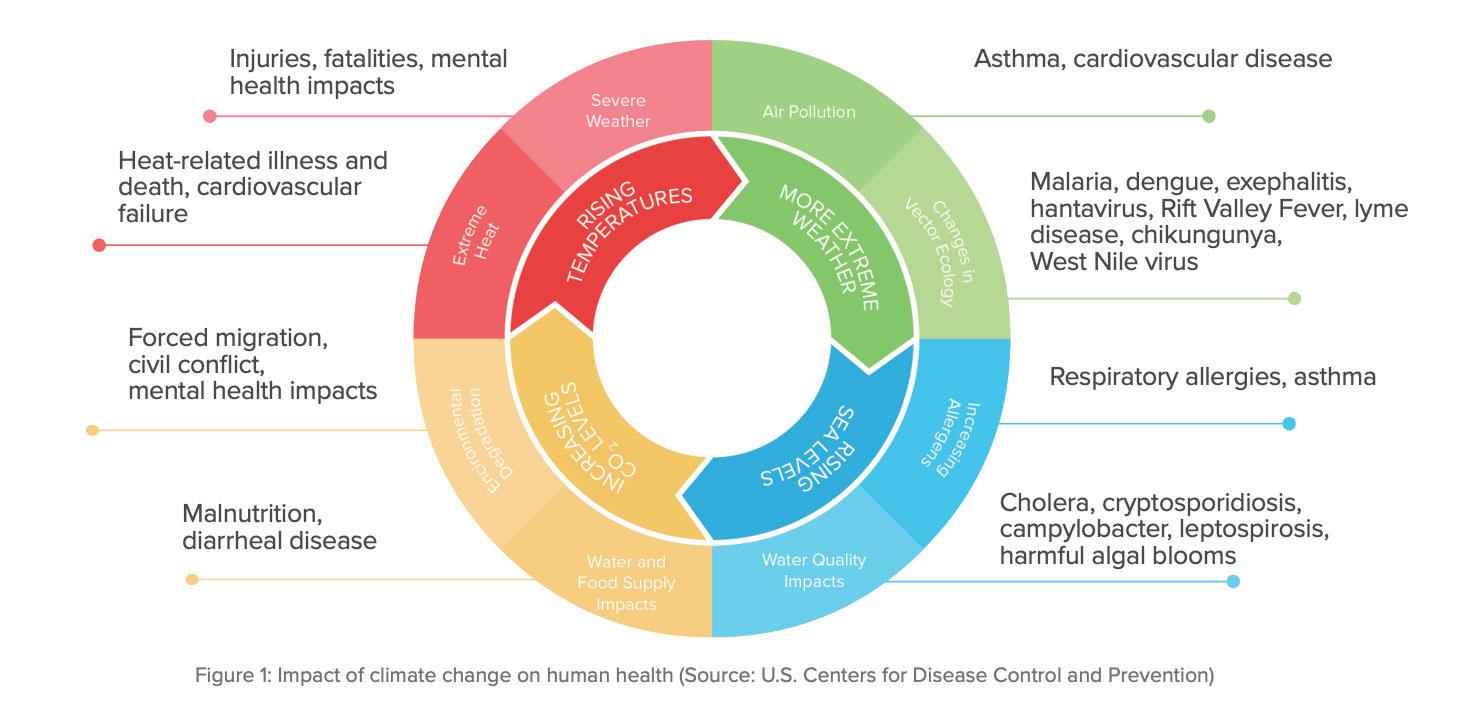
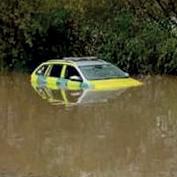
The climate and ecological emergency is fundamentally a health emergency. The impacts it has on health and healthcare systems are at once local, national and global. They include those related to extreme weather events, for instance, heat-related illness during heatwaves, trauma presentations during floods, and health infrastructure breakdown; emerging climate-sensitive infectious diseases; disruptions to food supply and water quality; pressures arising from climate-related conflict, migration and displacement; and the mental health problems that are set to intensify as all of these impacts occur with increasing frequency and severity. 1,2
Poor environmental conditions (e.g. air pollution caused by the burning of fossil fuels, which also leads to climate change) contribute to major diseases such as cardiac problems, asthma and chronic obstructive pulmonary disease. Systems and policies that are centred around fossil-fuel-dependent modes of transport, energyinefficient buildings and diets high in red or processed meat and dairy all harm human health and contribute to unsustainable levels of pressure on the provision of

6 Environmentally Sustainable Emergency Medicine
1
2 Add mental health reference
https://www.lancetcountdown.org/data-platform/health-hazards-exposures-and-impacts
Healthcare professionals have a responsibility to upscale efforts to reduce their own contributions to the core underlying driver of this crisis: greenhouse gas (GHG) emissions.
Note: Of the seven main GHGs that contribute to anthropogenic (human-caused) global heating – carbon dioxide (CO2), methane (CH4), nitrous oxide (N2O), sulphur hexafluoride (SF6), hydrofluorocarbons (HFCs), chlorofluorocarbons (CFCs) and perfluorocarbons (PFCs) – CO2 forms the majority. For this reason, ‘carbon’ is used throughout this handbook as shorthand for all GHGs, although in some cases other non-carbon GHGs are more relevant.
Please see the net-zero glossary from the Royal College of Emergency Medicine (RCEM) at the end of the handbook for more information.
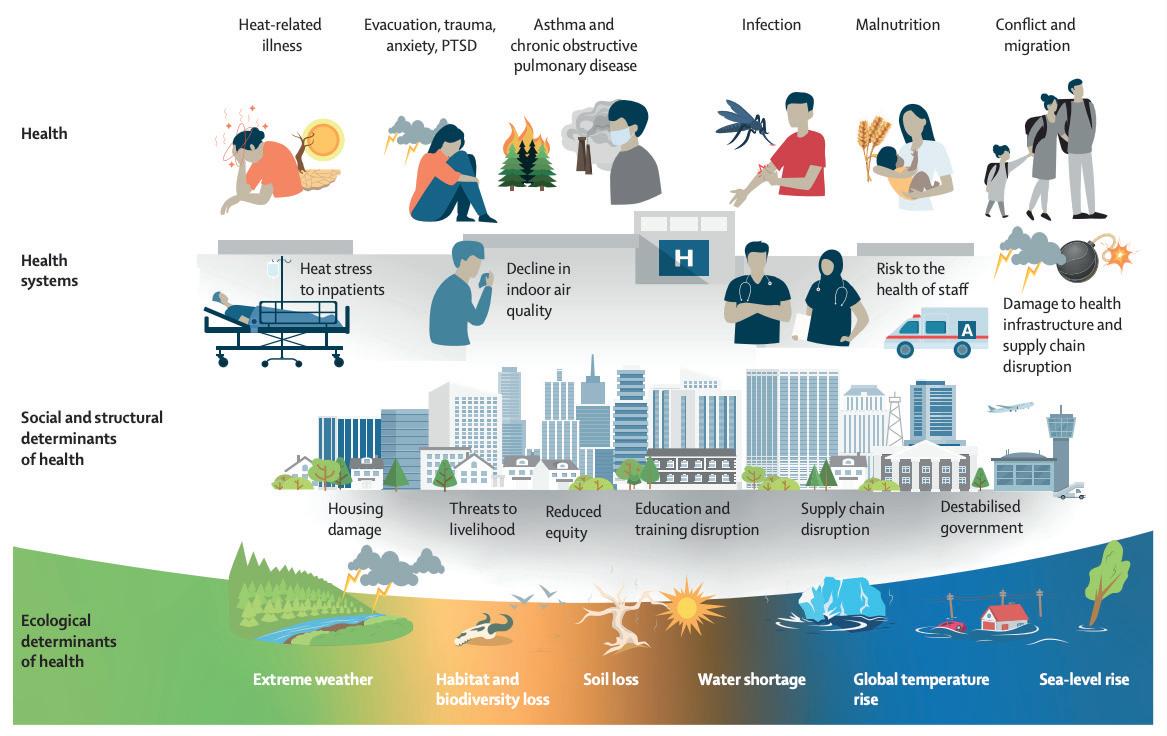
7 Environmentally Sustainable Emergency Medicine
Figure 2: Climate-change-related impacts of health and health systems (Source….3)
3 https://www.thelancet.com/journals/lanplh/article/PIIS2542-5196(23)00022-0/fulltext
Healthcare as a driver of climate change
The National Health Service (NHS) is responsible for an estimated 4% of the UK’s total carbon emissions, expressed as CO2e 4. This encompasses over a third of public-sector emissions, making it the biggest public-sector contributor to the national carbon footprint 5. This proportion is broadly reflected in healthcare systems throughout the world 6 Carbon emissions in healthcare settings are divided into three categories, as per the GHG protocol. These are listed below and shown in Figure 3.
Scope 1
Scope 2
Scope 3
Direct emissions from healthcare facilities, e.g. GHGs from anaesthetic gas use.
Indirect ‘upstream’ emissions from purchased energy, e.g. heating and lighting of hospitals, primary care facilities and other buildings.
Indirect emissions that are not included in Scope 2, which occur in the supply chain from both upstream and downstream sources, e.g. energy used to produce the products that are then used to provide emergency care.


Alongside global heating, healthcare contributes to the related environmental crises of air pollution and contamination caused by plastic and pharmaceutical wastes 7. These in turn damage human health.
4 To take into account the emission of greenhouse gases other than CO2 when calculating carbon emissions, scientists have devised an equivalent measure – carbon dioxide equivalent (CO2e). The use of this measure enables the representation of other GHGs in terms of CO2, based on their relative global warming potential
5 REF SUPPLIED BY GNHS (Manraj) - NHS carbon footprint estimated at 25Mt in 2019, whereas emissions in England due to consumption of fossil fuels in 2019 were 654 Mt (Figure 2 dataset - GOV.UK (publishing.service.gov.uk) ). 25/654 = 3.8%
6 Health Care Without Harm (HCWH) Carbon Footprint of Healthcare report 2018
7 HCWH plastics report: https://journals.sagepub.com/doi/full/10.1177/01410768211001583
8 Environmentally Sustainable Emergency Medicine
Figure 3: Greenhouse Gas Protocol scopes 1, 2 and 3 (source: Greenhouse Gas Protocol)
Why we need to act now
Climate change threatens the core purpose of the NHS – to protect and improve the health of current and future generations – and its impacts are already being felt in the UK. In the summer of 2022, heatwaves caused computer-system failures in hospitals in London, leading to cancelled operations and diversions of acutely unwell patients to hospitals other than the one at which they expected to be treated 8. During this same summer, there were 2803 excess deaths among people aged 65 years or over (excluding deaths due to COVID-19). 9
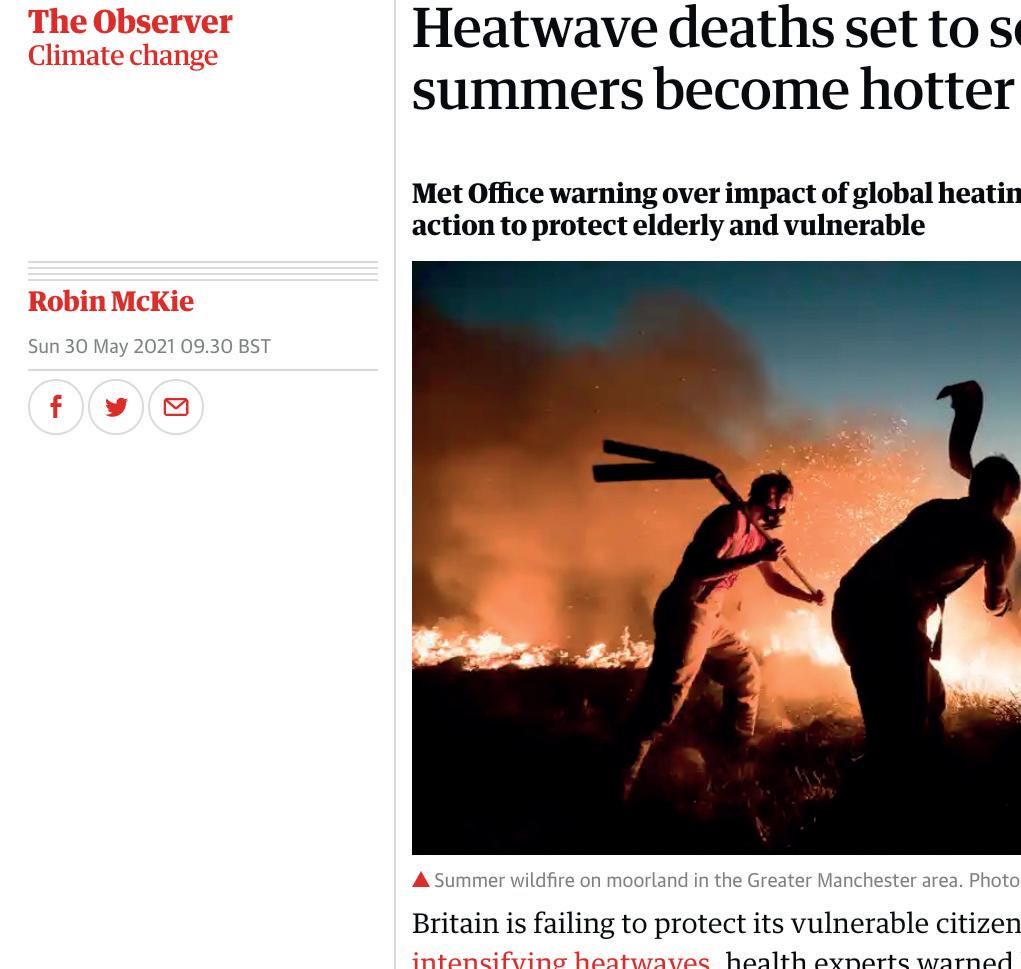
On the bright side, the climate and ecological emergency presents an unparalleled opportunity for substantial health co-benefits as the world shifts away from fossil fuels towards cleaner energy, transport, infrastructure and food systems. Action on climate change should bring direct improvements to public health and health equity.
Achievement of the UK’s ambitions under the Paris Agreement on climate change could see more than 5,700 lives saved every year due to improved air quality; 38,000 lives saved every year as the population becomes more physically active; and more than 100,000 lives saved
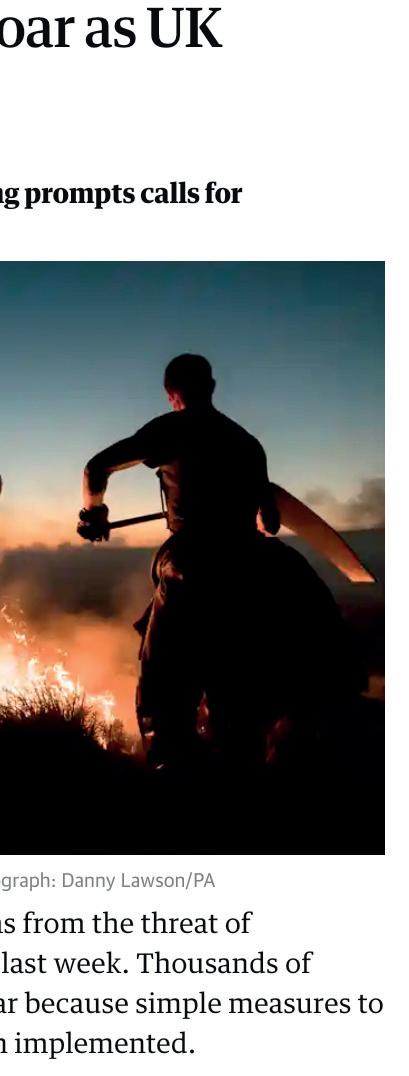
8 https://www.bbc.co.uk/news/uk-england-london-62337105 accessed 4 May 2023
9 https://www.gov.uk/government/publications/excess-mortality-during-heat-periods-1-june-to-31-august-2022
10 Greener NHS (also https://www.sciencedirect.com/science/article/pii/S2542519620302497 needs checking)
9 Environmentally Sustainable Emergency Medicine
Likewise, low-carbon healthcare may mean better healthcare. In the context of the current emergency care crisis, the use of resources at optimum efficiency saves money, and in many cases, carbon savings can be made alongside financial savings. For example, reductions in the number of unnecessary investigations (such as scans or blood tests) may result in measurable cost and carbon savings as well as improvements in patient experience and/or health outcomes (e.g. reduced radiation exposure from imaging, or reduced pain and discomfort associated with venepuncture).12
The NHS must tackle climate change and pollution at its sources if it is to deliver on the ambition of the Long-Term Plan.13 As the largest employer in Europe, with 1.3 million staff, and as a national ‘anchor institution’ 14, the NHS is ‘part of the problem’ with respect to climate change, but it is in a strong position to be part of the solution. 11 https://www.thelancet.com/journals/lanplh/article/PIIS2542-5196(23)00022-0/fulltext
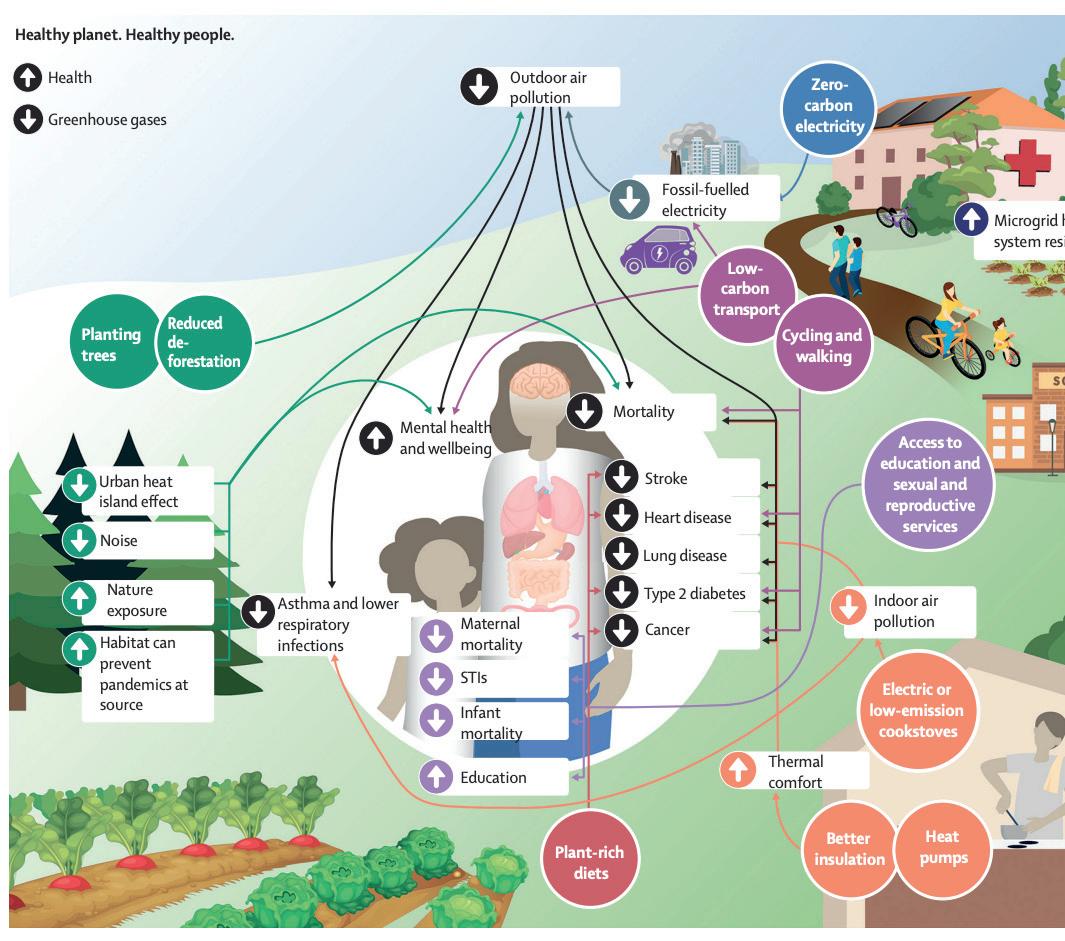
10 Environmentally Sustainable Emergency Medicine
12 Choosing Wisely / ?GIRFT 13 Reference? 14 Add definition of ‘anchor institution’
Figure 4: Co-benefits to health of measures that reduce GHG emissions (Source:... 11)
Emergency Medicine within a Net-Zero NHS
ED staff, both clinical and non-clinical, across the UK, played a critical role in the COVID-19 pandemic response. Over the next decade and beyond, we will play an important role in caring for patients affected by the climate emergency.
EDs are resource-intensive, high-pressure environments. There is a lot of room for improvement in the way we use those resources, despite departmental imperatives (e.g. maintaining the highest possible standards of patient care) and constraints (e.g. stretched budgets, understaffing, lack of time). Even in a busy clinical workplace, significant sustainability ‘wins’ can be initiated and achieved by staff themselves. Making these changes has the potential to benefit the environment and to ensure sustainability and quality of emergency care provision in the immediate-, medium- and long-term. 15
Background: net-zero NHS targets
In 2019, the UK became the first major economy in the world to make a legally-binding commitment to cut emissions of CO2 and other GHGs to net-zero by 2050.16 This follows from the 2008 Climate Change Act, which set the statutory targets that emissions had to be reduced by 34% by 2020 and by 50% by 2025, against a 1990 baseline.17
The NHS was one of the first national health systems to start to measure its carbon emissions and to produce a carbon reduction strategy.18 This move enabled it to meet and exceed the 2020 targets outlined in the Climate Change Act. More recently, targets have been set by all the devolved nations.
England
In 2020, in response to the escalating threat to health posed by climate change, NHS England boosted its ambitions by becoming the first health service in the world to commit to reaching net-zero carbon emissions.19 Two mandatory targets were set:
- To reach net-zero in terms of directlycontrolled emissions by 2040, with an 80% reduction by 2028-2032.
- To reach net-zero by 2045 in terms of wider emissions that the NHS influences, with an 80% reduction by 2036-2039.
Greener NHS is the national NHS England programme set up to deliver this UK commitment, a detailed plan for which is outlined in the Delivering a Net-Zero NHS report.20 Every element of the strategy is designed to improve health- and patient care outcomes and to reduce system inefficiencies, and health inequalities, and to deliver a more resilient healthcare system.
The Health and Care Act 2022 placed a new duty
on NHS England organisations to consider climate change in their operations. It meant that the NHS became the first healthcare system to have netzero embedded in legislation. All NHS Trusts, Foundation Trusts and Integrated Care Boards/ Systems are now required to contribute towards statutory emissions and environmental targets. All 212 NHS Trusts in England now have Green Plans in place.
15 https://choosingwisely.co.uk/recommendations-archive/#1476654326462-140275b8-1d63
16 HM Government. UK becomes first major economy to pass net zero emissions law. 2019. www.gov.uk/government/news/uk-becomes-first-majoreconomy-to-pass-net-zero-emissions-law
17 www.sduhealth.org.uk/policy-strategy/legal-policy-framework/climate-change-act.aspx
18 REFERENCE
19 https://www.england.nhs.uk/greenernhs/wp-content/uploads/sites/51/2020/10/delivering-a-net-zero-national-health-service.pdf

11 Environmentally Sustainable Emergency Medicine
a `Net Zero` National Health Service,
be
at
(england.nhs.uk)
20 Delivering
NHS England can
found
B1728-delivering-a-net-zero-nhs-july-2022.pdf
The NHS in Scotland has developed the climate emergency and sustainability strategy 2020-2026. The aim is that it will become a net-zero healthcare system by at least 2040 and its supply chain will become net-zero by 2045.
On sustainable care, the strategy states: “Each Health Board which provides clinical services will establish a sustainable clinical service delivery function as a core part of its Climate Emergency Response Team. This function will support clinical teams across the NHS to make clinical services environmentally and socially sustainable.”
Scotland Northern Ireland Wales
NHS Wales has published a decarbonisation strategic delivery plan, which contains detailed descriptions of 46 initiatives that cover the emissions listed in scopes 1, 2 and 3. NHS Wales has made £16 million available as capital finance. It has employed a stepwise approach to carbon reduction and has set specific targets for 2025 and 2030.
The decarbonisation plan states that the role of ‘decarbonisation programme manager’ will be created as a dedicated position to drive the focused implementation of the plan:
“Each Health Board, Trust, special body, and [NHS Wales Shared Services Partnership] Procurement will develop an Action Plan every two years as stipulated, with the first to be published by March 2022. Each plan will detail how the respective organisation will implement the initiatives set out in
Currently, the health and social care sector has no health-specific decarbonisation plan; however, Northern Ireland’s Climate Change Act states: “The Northern Ireland departments must ensure that the net Northern Ireland emissions account for the year 2050 is at least 100% lower than the baseline.”
As part of this Act, Northern Ireland is developing a climate action plan, to which the Department of Health NI has contributed. It is focused on energy, waste, transport and public buildings.
The RCEM represents emergency care workers throughout the devolved nations. As each country develops its response to the climate crisis, the GreenED group will endeavour to support EDs, wherever they are in the UK, to achieve these goals.
At the workforce level, environmental action aligns with the values and concerns of health professionals in the UK who, like the general public, are increasingly alarmed by the climate crisis. A 2017-2019 survey by the (since restructured) Sustainable Development Unit found that the vast majority of NHS staff believed that it was important to be environmentally responsible in the workplace and at home; 98% believed that it is important for the health and care systems to support the environment.21 A more recent survey showed that nine in ten NHS staff who were aware of the net-zero ambition supported it, and a growing number – eight in ten – have taken action to meet this ambition in their professional lives. Measures taken included saving energy, recycling waste, taking greener routes to work or improving their prescriptions, such as by switching to anaesthetic agents with a lower-carbon footprint than those previously used.22
Research and innovation are important enablers that can reduce NHS carbon emissions through the discovery of new approaches to the delivery of care that will protect and improve the health of patients, the public and future generations. Greener NHS is working on several key actions to drive this forward. For details, visit Greener NHS Knowledge Hub -
Figure 5: At the United Nations Climate Change Conference of the Parties (COP) 26, the NHS unveiled the world’s first zero-emission, electric ambulance with a hydrogen fuel cell range extender. It can travel up to 300 miles before it requires refuelling.

12 Environmentally Sustainable Emergency Medicine
21 www.sduhealth.org.uk/areas-of-focus/leadership-engagement-and-workforce-development/engagement/staff-and-sustainability-survey.aspx
What the RCEM is doing about the climate and ecological crises
The RCEM is a founding member of the UK Health Alliance on Climate Change (UKHACC), which comprises UK-based health organisations that represent about one million health professionals. It was set up in 2016. Through the UKHACC, RCEM has used its voice to promote the health benefits that can be brought through urgent societal action on climate change and air pollution. Recently, the UKHACC has created a set of guiding principles, through the use of which health organisations can demonstrate leadership and take steps to mitigate and adapt to climate change.23 The RCEM continues to show its climate leadership by endorsing and working to achieve these commitments.
The emergency medicine (EM) community, in the UK and internationally 24,25,26,27, has started to mobilise and act on climate change, particularly during the last four years. In 2019, the RCEM responded to suggestions proposed by concerned members – amidst growing public awareness –by divesting from fossil fuels, formally declaring a climate emergency, co-launching the annual Lancet Countdown Report and starting to reduce its environmental footprint and that of its activities. The RCEM also set up the Environmental Specialist Interest Group (ESIG), which was tasked with researching and developing ways to assess and improve the environmental sustainability of everyday clinical practice, as part of a wider advocacy and education remit. Since there are an estimated 130 EDs in England and Wales alone, it is crucial to understand how these sites of acute-care provision within hospitals can mitigate their environmental impacts.
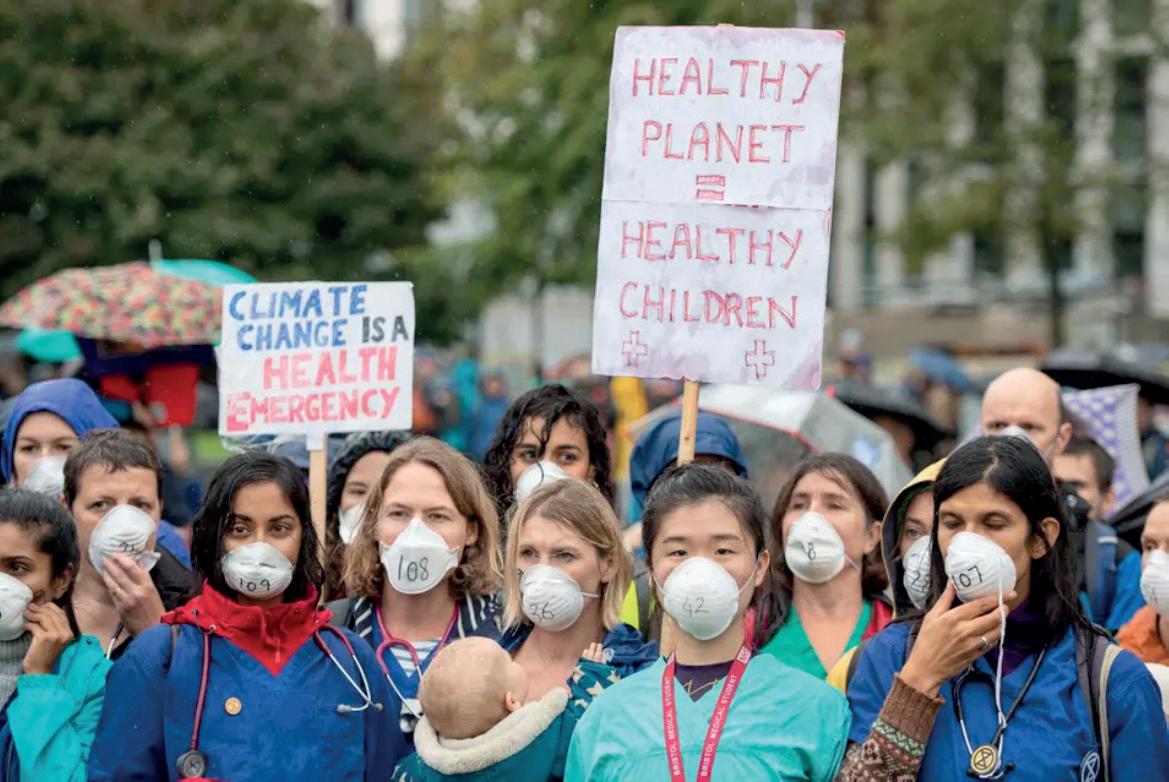
13 Environmentally Sustainable Emergency Medicine
YouGov, April 2022
https://ukhealthalliance.org/about/our-commitments/
Lemery, J. Peering through the hourglass. Emerg Med J 2017;34:272-274
ACEM position statement on climate change 26 The Climate Smart Emergency Department: A Primer. Annals of Emergency Medicine 2020
22
23
24
25
The GreenED programme
In order to respond to a problem as immense as the climate and ecological emergency – and the threat it poses to health and healthcare around the world – it is imperative to break ‘the whole’ into small, achievable parts. There is a lot that frontline staff and senior management can do within EDs to reduce the environmental impacts of the everyday care we provide, and quantifiable drops into the green bucket will all add up if we take a coordinated, systematic, evidence-based approach. GreenED is the means through which our workplaces and thereby the specialty of EM can make a significant contribution to a net-zero NHS by 2040, as part of the urgent national and global drive towards carbon neutrality
The idea for GreenED arose amongst ESIG members in 2019. It was inspired by the Laboratory Efficiency Assessment Framework (LEAF), a framework for sustainable action that was drawn up by laboratory staff. By 2023 it has been developed into a comprehensive, RCEM-administered programme that aims to equip ED staff to:
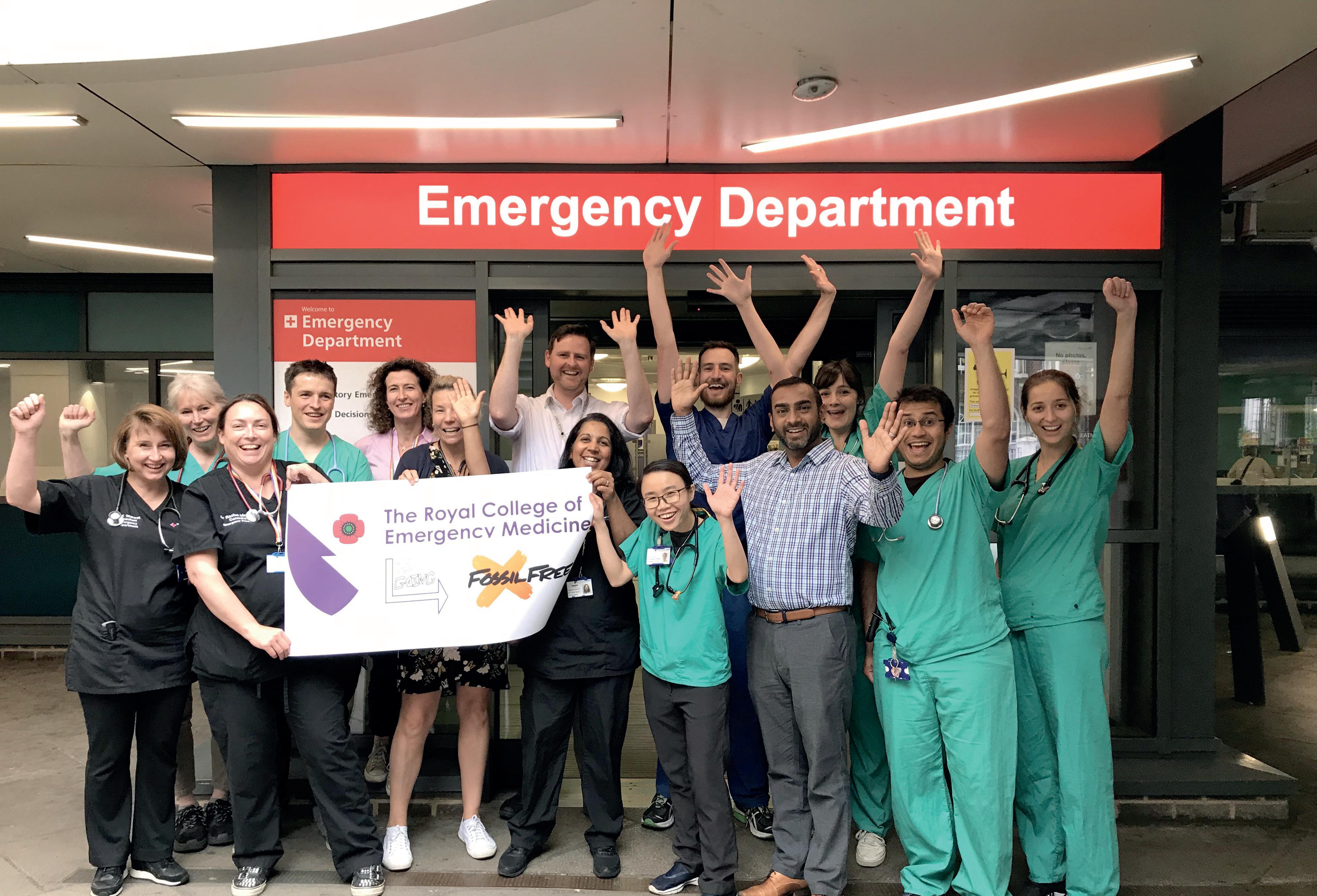
- measure and reduce the environmental impacts of everyday departmental practices while maintaining or improving standards of patient care;
- identify and – where possible – quantify potential co-benefits in the form of cost savings, improved operational efficiency (e.g. staff time, resource use) and/or increased wellbeing (e.g. patient experience, staff morale/motivation arising from effective teamwork, acting in line with shared concerns, and being part of a values-led workplace 28); and
- boost engagement amongst colleagues interested in taking action on the climate, environmental and healthcare sustainability agenda.
14 Environmentally Sustainable Emergency Medicine
27 Climate Change and Health: An urgent call to academic emergency medicine. Academic Emergency Medicine 2018 28 How companies can tap sustainability to motivate staff Thinkbig,startsmall,scalequickly
GreenED Aims



Environmental Impact Environmental Engagement
Maintain or Improve Standards of Patient Care

I. GreenED Framework and Online Portal



Framework 1.0 - the pilot project 29
The RCEM’s GreenED pilot project ran from November 2021 to July 2022. The aim of it was to standardise and stratify what actions ED staff could take at work to improve operational sustainability while maintaining or improving standards of patient care. At the outset, a working group of junior doctors, consultants and an advanced care practitioner was engaged on what actions might be feasible and this was condensed into the GreenED Framework 1.0. The process was based on the already successful LEAF programme, which is a certification in sustainable laboratory operations managed by University College London.
Eight EDs were engaged in implementing Framework 1.0. Outcomes included estimated carbon savings of 153.7
Framework 2.0 (2023 onwards)

Framework 2.0 structures actions into three levels of feasibility, with bronze being the easiest to achieve and gold being the hardest. They each comprise six domains (see Table 1 below), mapped to net-zero NHS categories. This is to enable the use of a systematic, stepwise approach to tackling sustainability issues that occur on the ground.
The actions are designed to be specific and measurable

15 Environmentally Sustainable Emergency Medicine
https://knowledge.wharton.upenn.edu/article/how-companies-tap-
Shrink down and make more consistant.
Infographics: bronze, silver and gold actions

The actions have been split into six categories or domains to help to identify related actions. The first, Organisational & Leadership, is about staff engagement and capacity-building (a core element of the transition to a net-zero NHS).30 The others are mapped to relevant sources of carbon emissions in healthcare31 in order to tackle known carbon hotspots in an acute-care setting.
Category/domain
Organisational & Leadership
Definition
These actions focus on staff engagement, networking and organisational structures of EDs and Trusts to make the implementation of environmentally sustainable changes more likely to succeed.
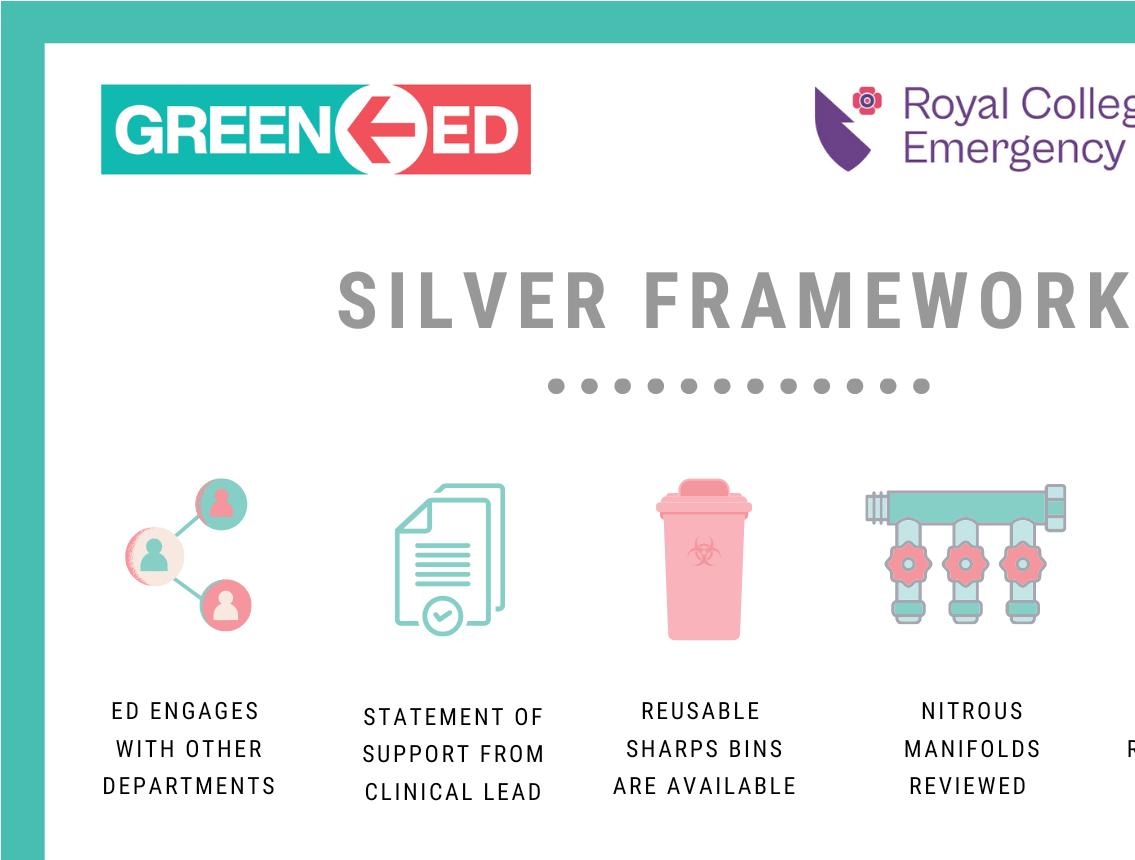




Facilities & Estates
Anaesthetic Gases & Inhalers

Procurement

Patient Pathways
These actions work to ensure that the physical structures and functions of an ED are as energy efficient as possible. They include waste segregation and disposal.

These actions focus on reducing the use of anaesthetic gases and inhalers – sources of direct GHG emissions produced by emergency care – that have high global warming potential.
These actions highlight sustainable changes in how EDs procure equipment and opportunities to reduce the use of single-use consumable items and packaging.


These actions focus on the patient journey, and how we can make more sustainable choices in the management plans that we create, for instance by reducing the use of unnecessary investigations, avoiding admissions and moving towards virtual clinics / other telemedicine initiatives.

16 Environmentally Sustainable Emergency Medicine
sustainability-to-motivate-staff/ 29 RCEM pilot report 2022
Table 1: Framework categories/domains
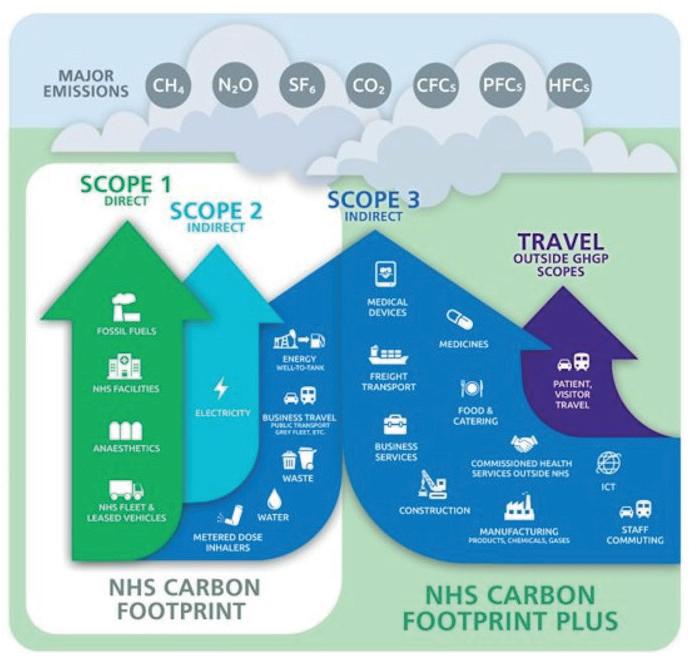

17 Environmentally Sustainable Emergency Medicine
How to use the GreenED portal: subscription and FAQs
Through the portal, participating EDs will be able to input qualitative feedback and quantifiable impacts from green interventions to a centralised data collection system. This, in turn, will inform the actions and over time will build the evidence-base for sustainable EM; i.e., the framework will be updated periodically via an iterative process. Results will feed into wider sustainability targets at both the Trust and the national levels. Greener NHS is working closely with the RCEM to ensure data sent in by individual sites is aligned with net-zero NHS metrics and targets.
Support, assessment and accreditation
GreenED support, assessment and accreditation processes

The GreenED Framework 2.0 online portal is accompanied by a wealth of resources and a wide range of activities in which EM staff can engage, to address and implement environmentally sustainable actions in their EDs. The content includes resources, inductions, ongoing support, troubleshooting and question&answer sessions. We aim to collaborate with you to embed environmentally sustainable actions in your department.
We will provide incentives and recognise the efforts of EDs to adopt sustainability practices at GreenED bronze, silver, or gold levels.
18 Environmentally Sustainable Emergency Medicine
Resources
You can access a wide range of GreenED and broader resources through the online portal. These resources include the GreenED Handbook, tools, infographics, videos and how to guides, to help you understand how you can contribute to reducing the operational carbon footprint of your ED as part of our collective drive to deliver net-zero healthcare.
Ongoing Support
We will provide support through diverse channels, e.g., email, monthly meetings and networking events; these will enable conversations that resolve enquiries from participating EDs and help them to realise sustainable practices at an operational level. Engagement is optional, but typically helps ED programmes to become successful.
Events
We offer monthly webinars, workshops and an annual environmental study day to bring EM staff together to share their experiences and best practices in the implementation of sustainable practices in EDs.
Induction
When your ED signs up for the GreenED 2.0 programme, the GreenED working group/ administrators will be invited to join a one-hour induction for a representative of your ED. This is open to any individuals leading or taking part in the programme. At the induction, we will provide an overview of the GreenED programme and healthcare principles, highlight high-impact areas of environmental sustainability, and give you a solid understanding of the programme’s mission. Each ED should follow the GreenED programme timeline, activities and resources to ensure successful completion and delivery of that ED’s GreenED level.
Regular Communication
We will keep you informed through use of our diverse channels, which include email, social media and our monthly newsletter, to share information about the GreenED programme, funding opportunities and any updates or changes that may
Celebrate Achievements
We will keep you informed through use of our diverse channels, which include email, social media and our monthly newsletter, to share information about the GreenED programme, funding opportunities and any updates or changes that may
Programme timeline
Interested EDs can sign up for the GreenED programme all year round. Within a few weeks of joining the programme, representatives will be invited to an induction session, which is delivered at the end of each month, probably on the same day as the monthly catch-ups. During onboarding, we will empower ED site leads (and GreenED working group members) with overviews of the GreenED programme, healthcare/environmental sustainability principles, the NHS netzero policy, the environmental impact of emergency care, monitoring and reporting metrics, and ways to communicate GreenED goals and achievements.
The portal will be open for submission of evidence towards GreenED certification/accreditation every six months. We will also inform ED sites of the expectation to implement actions at bronze, silver, or gold level over a six-to-eight month period so that they can submit evidence for accreditation and recognition. For example, if an ED signs up in June 2023, they can submit evidence between January and February 2024. This is the programme timeline:
- 1 January - 29 February 2024: GreenED online portal opens for EDs to submit evidence for accreditation.
- 1 March - 30 April 2024: GreenED assessors review and give feedback.
- 1 June - 31 July 2024: GreenED online portal opens for EDs to submit evidence for accreditation.
- 1 August - 30 September 2024: GreenED assessors review and give feedback.
- November - December 2024: GreenED team conducts an annual review of content to ensure that the portal remains relevant and incorporates emerging evidence in the field; creates informational videos, among other activities.
19 Environmentally Sustainable Emergency Medicine
After you have submitted evidence of how you have achieved each action in the bronze, silver or gold level (which will require a minimum period of evidence collection of six-to-eight months), we will review your submission as part of the assessment process and meet you before we provide feedback in preparation for accreditation. At the end of the review, assessment and discussion process, we will upload a summary response and send you feedback through the Our Feedback tab, and we will inform you of our decision.

20 Environmentally Sustainable Emergency Medicine
Figure 8: Timeline of GreenED assessment and accreditation processes
II. Taking Action on Shopfloor Sustainability Where to Start?
The general idea is to start with bronze actions; many of them are precursors to the achievement of silver and gold actions in the same domain, and going for bronzelevel accreditation provides a focus for collective efforts. However, there is flexibility to address silver and gold actions in parallel. This is in recognition of the fact that what’s easy to change in one ED might be a lot harder in another, and because some EDs will have already achieved or be close to achieving different actions prior to initiating the framework (for example, some EDs might already have methoxyflurane available as an alternative to
Bronze action #1 how to set up (and maintain) a green group
The formation of a group of motivated ED staff, both clinical and non-clinical, will make addressing GreenED actions more fun, effective and sustainable. The group doesn’t have to be big, but the more multidisciplinary it is, the better. Nurses, doctors, healthcare assistants (HCAs), porters, cleaners and office staff, i.e. clinical, domestic, administrative and managerial staff members, will each have different perspectives on departmental problems. What’s more, a diversity of experiences will lead to more ideas on how to solve them.
Your hospital/Trust should have a sustainability lead and may already have a green network that is mobilised around delivery of its Green Plan. But if there are no ED staff involved yet, here are some ideas for how to start a Green Group.



‘Top tips’ on setting up a green group
N2O).
In terms of domains, ‘Organisational & Leadership’ should be addressed first at all levels to encourage early prioritisation of these actions. This is because together, organisation and leadership represent a solid foundation on which to implement GreenED locally, maintain momentum and ensure success in the future. These sectors emphasise a team-based approach and the importance of increasing staff capacity to implement green initiatives on an ongoing basis. This means the work won’t
21 Environmentally Sustainable Emergency Medicine
Figure 9: GreenED noticeboard at John Radcliffe Hospital, Oxford, 2022.
Figure 10: GreenED team at the Royal Free Hospital, London, 2021.
Silver action #2 Senior support
Junior staff are often the ones who drive forward the environmental agenda. However, engaging senior staff members early on will make departmental changes a lot easier to achieve. The GreenED pilot that was run in 2022 found that without this engagement, the achievement of such changes were made much more difficult than with it.32 Support and buy-in from both clinical leads and managers will help to ensure continued success in improving both cultural and practical aspects of environmental sustainability. Importantly, such support will buffer/safeguard against/mitigate the risk of individual efforts going to waste; such efforts within NHS Trusts are often likened to ‘wading through treacle’.
‘Top tips’ on securing senior support for GreenED projects
- Sustainability as a pillar of quality improved service provision/patient experience
- Cost incentives / financial savings
- Time savings/staff wellbeing
- Sustainability/carbon targets becoming mandatory
- Need for adaptation/mitigation to prepare EDs for what’s to come, e.g. risk of floods in departments
RCEM position statement
Note: This is in development as of May 2023 and will be linked to when published.
Gold action #1 protected staff time
Sustainability work takes time and energy, two things that are in short supply amongst NHS staff. During the pandemic, the rate of burnout among emergency medics was particularly high. Although GreenED may be started/seeded in any department, by anyone, it will be essential to set aside time in which doctors, advanced clinical practitioners (ACPs), nurses and other ED staff, both clinical and non-clinical, will be able to embed sustainability into EM.
There are several ways in which protected time can be provided to staff who are tackling environmental issues and addressing GreenED actions. ‘Admin days’ can be allocated to nursing staff and HCAs on an ad-hoc basis for specific projects. Clinical fellowships in environmental sustainability have been undertaken by middle-grade doctors in several EDs throughout England. These may be tied to a quality improvement (QI) role, or offered as a more generic post, typically with an 80/20% clinical/ non-clinical split. One highlight from the pilot project was the offer of a sustainability post to a pilot site lead due to the effort they had put into addressing GreenED bronze
“As a trainee, I enrolled Royal Preston Hospital in the GreenED pilot project and we achieved bronze accreditation in 2022. Our clinical lead was very supportive, recognising the positive impacts we were making in terms of staff morale and motivation, financial savings, increased efficiency and improved patient care. After the pilot ended we discussed how we could continue our momentum and support sustainability work in the ED, recognising that protected time was important. As a result, Royal Preston Hospital created a position for a clinical fellow in sustainable emergency medicine.
This role has an 80:20 split between clinical and non-clinical work, and with this protected time I have been able to achieve much more. Having sustainability in my job description also adds an element of legitimacy, and has helped to facilitate engagement with other departments within the Trust.”
– Dr Frances Balmer
22 Environmentally Sustainable Emergency Medicine
30 https://www.england.nhs.uk/greenernhs/a-net-zero-nhs/areas-of-focus/
EM trainees, candidates for the Certificate of Eligibility for Specialist Registration (CESR), ACPs, locum and specialty doctors can each use some of their time on non-clinical ‘admin days’ to align sustainability work with their portfolios and continuing professional development to meet requirements for annual appraisal and revalidation. (For more detail, see section III below.)
At the consultant level, environmental sustainability will probably become a standard aspect of departmental management and performance metrics in the near future, and supporting professional activities will be required for senior staff to ensure that net-zero NHS targets are on track.
In the meantime, just taking the steps to ensure that staff have protected time achieves a GreenED action!
Sample job description: EM clinical fellow in sustainability. Note. This will be uploaded to the toolkit and linked here soon.
III. How to use GreenED actions for your portfolio
The 2021 RCEM curriculum
Since 2021, the GreenED programme has been easily mapped to the RCEM curriculum for trainees, CESR candidates and ACPs, as sustainability projects are now formally recognised by the college, alongside clinicallyfocused criteria. This is an excellent opportunity for you to evidence learning outcomes whilst having a beneficial impact on the environment and human health. Below are some suggestions, but be creative and let us know what you come up with!

- SLO-9: support, supervise and educate organise a local or regional teaching day/session that is focused on environmental issues.
- SLO-10: participate in research and manage data appropriately. Engage with GreenED Framework
2.0. Calculate emissions and track change within your department. Collate evidence using quality improvement assessment tool (QIAT) forms. An example is shown to the right.

- SLO-11: participate in and promote activities to improve the quality and safety of patient care. GreenED goals are closely linked to quality and safety.
- SLO-12: manage, administer and lead become your local green champion and make a real impact on healthcare sustainability. Lead green QI projects in your department in line with the GreenED programme.
23 Environmentally Sustainable Emergency Medicine
Example QI projects (QIPs) see section VI below
Example management projects
‘No to N2O’: Switching from nitrous oxide to methoxyflurane (Royal Devon and Exeter Hospital, South West England)

‘Reusable suture kits for the future’ (Royal County Sussex Hospital, South East England)



A Note for ACPs
As of May 2023, the RCEM is in the process of recruiting an ACP representative to join the ESIG. We are keen to build a network of ACPs who are interested in environmental sustainability and taking part in GreenED. Email ESIG at environment@rcem.ac.uk to find out more!
24 Environmentally Sustainable Emergency Medicine
Figure 11: The prototype suture pack developed by pilot site lead, Hannah Webb
IV. Stakeholder engagement
Who’s who within an ED, hospital, Trust and beyond?
This series of stakeholder maps is intended to give an informative, accessible overview of the various roles relevant to GreenED at the departmental, hospital/Trust, national and international levels.

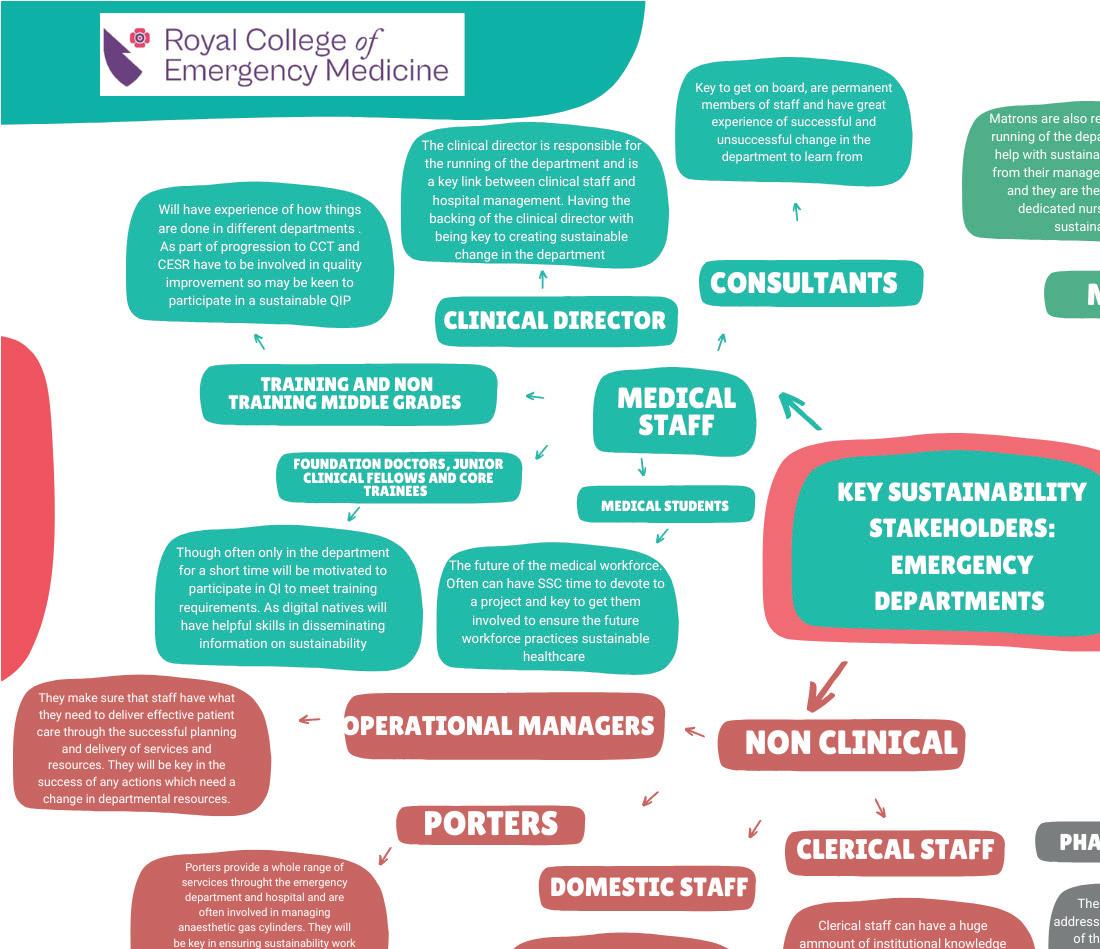
Silver action #1 involves engagement with colleagues within your wider hospital and Trust. You might not have done this before. Here are some ‘top tips’ on stakeholder engagement outside the ED to help you get started.
- Connect with your sustainability manager and green network if your hospital / Trust has one.
- Connect with leads in key departments such as procurement, estates and facilities, catering and information technology (IT), and with transformation / executive leadership teams. Find out what they’re already working on in terms of environmental sustainability. Ask for support on specific aspects of the GreenED framework and be clear about what it is you’d like their help with.
- It may take some time to figure out who’s who –making a contact list can help you to keep track.
- Use hospital comms to link in with other initiatives, e.g. recycling week, to raise awareness more widely of GreenED as a pragmatic, staff-led solution to the climate and ecological emergency.
- See what the ambitions of your Trust’s Green Plan or net-zero strategy are and how GreenED aligns with them. It helps if you link your programme to Trust objectives, because that will help to bring senior decision-makers on board.
- In trying to engage any stakeholder, it is important to have an understanding of how sustainability goals align with the goals and work remit that the stakeholder may have. One of the most powerful alignments is to highlight the cost-saving effects of many sustainability projects. Being up to date with initiatives from the UK Government can help too; if you can show that a sustainability action meets a governmental/Integrated Care Board target for which the stakeholder is responsible, then this will help to engage them and move projects forward.
25 Environmentally Sustainable Emergency Medicine
Figure 12: An example of a stakeholder map
V. Carbon footprinting an ED
One of the ultimate goals of GreenED is to get EM to be as low-carbon as possible, thereby maximising our contribution to net-zero NHS targets. To achieve both these aims, we need to understand and measure the carbon costs that are incurred in everyday emergency healthcare service delivery. The RCEM’s GreenED team has created carbon calculators for specific actions to facilitate this process. These calculators draw on carbon conversion factors that correlate with departmental products and processes. However, data specific to emergency care is limited and this is an area that will gradually be increased.

To access the calculators and emission factors, sign up for GreenED Framework 2.0 via the portal.
‘Carbon hotspots’ in emergency care
The main ‘carbon hotspots’34 in emergency care have been identified as the heating and lighting of the department, the use of anaesthetic gases and the procurement and disposal of consumable items that we use on a day-to-day basis. See Table 2 below for some examples.
GreenED actions are focused on these areas, aiming to have as much impact as possible. The scope of the framework is defined further by hotspots that ED staff can influence.
26 Environmentally Sustainable Emergency Medicine
31 Greener NHS 2020 report and carbon emissions report 32 GreenED pilot report
Figure 14: The image breaks down the carbon costs of a visit to the ED by a person with an ankle fracture. (Source: the Sustainable Healthcare Coalition (SHC) 35)
Carbon literacy
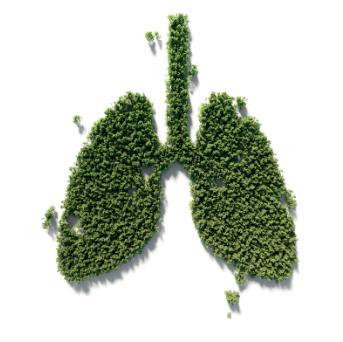
Health professionals must gain carbon literacy skills over time in order to assess the environmental impacts of our practice. We recommend the course Carbon Footprinting for Healthcare, run by the Centre for Sustainable Healthcare (CSH), as a good place to start. Greener NHS has endorsed this E-Learning Module on Environmentally Sustainable Healthcare, developed by NHS Health Education England and E-Learning for Healthcare, in partnership with the CSH. The Greener NHS Knowledge hub has links to various tools, resources, and information on how to become carbon literate.
VI. Green QI for EDs
Sustainability as a dimension of quality
Environmental sustainability has been identified as a seventh dimension of quality in healthcare.36 This may or may not be integrated into your Trust’s QI programme yet. It’s worth getting in touch with your QI lead to find out whether it is, and flagging it up if not.
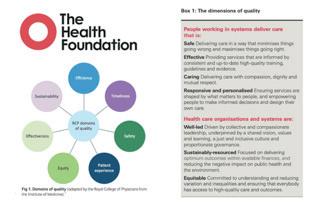
27 Environmentally Sustainable Emergency Medicine
“Planning for sustainability is so fundamental to health and to the continuation of care provision that sustainability should be considered an aspect of quality in healthcare.”
– CSH
34 Greener NHS Report ‘Trust Contributions to Carbon Footprint Plus’
Figure 15: the sustainable QI framework: principles and methodology
The CSH has developed a model of environmentally sustainable QI, or ‘SusQI’, in healthcare, based on four principles: prevention, patient self-care, lean service delivery and low-carbon alternatives.
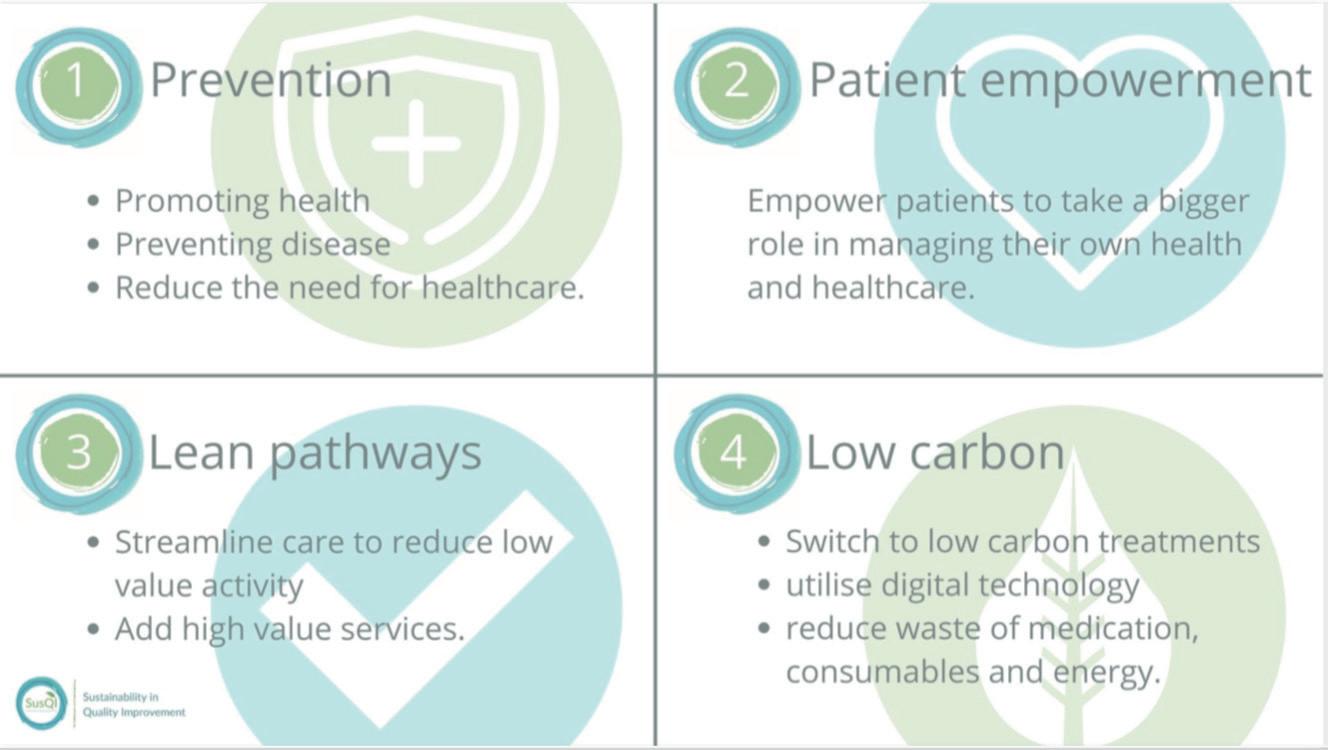

28 Environmentally Sustainable Emergency Medicine
Figure 16: the CSH’s four principles of SusQI in healthcare
These principles can be broken down further through the use of the CSH’s SusQI driver diagram:
These principles can be broken down further through the use of the CSH’s SusQI driver diagram:
The first four secondary drivers align with the principles of sustainable healthcare. The fifth, operational resource use, covers aspects that are not related to direct clinical care. However, they are an important part of day-to-day practice and clinical staff have professional responsibilities regarding them, as reflected in mandatory training modules on waste disposal.


29 Environmentally Sustainable Emergency Medicine
These principles inform the SusQI framework, the elements of which are listed below 37 The framework follows a step-by-step process (see Figure 17 below).

1. Aims to improve the sustainable value of healthcare by considering ‘the triple bottom line’

2. Understand environmental, social and financial impacts of the current system
3. Use the principles of sustainable clinical practice to design improvement

4. Measure the impact of sustainable value
35 https://shcoalition.org/wp-content/uploads/2019/10/6_3.-Sustainable-Care-Pathways-Guidance-Emergency-Department-Visit-Module-Oct-2015.pdf
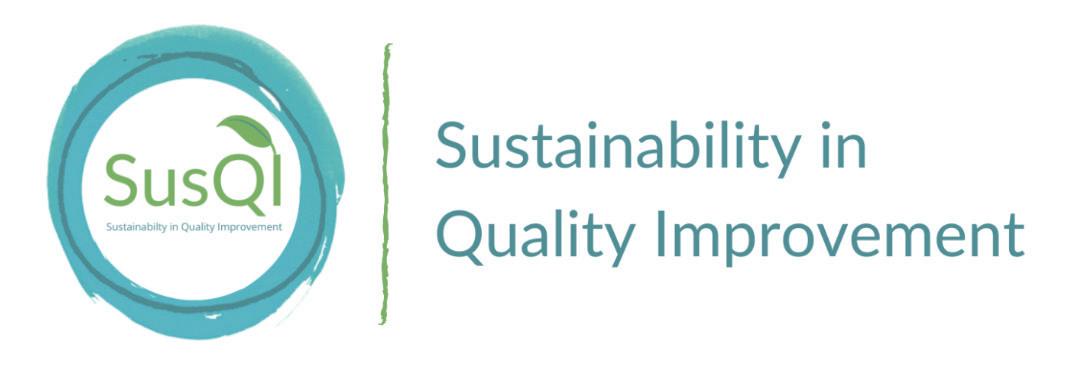
30 Environmentally Sustainable Emergency Medicine
Figure 17: the SusQI framework (Source: CSH)
‘Finding the wins’: environmental, financial and patient/staff benefits



At the RCEM, the ESIG and the quality assurance & improvement committee are working closely together to develop systems of care that are sustainable for the planet and population. Environmental objectives will be integrated into individual QIPs and the programme overall. Efforts will be made to ensure that national QIPs align with the GreenED framework, where relevant.
The RCEM is also working towards the development of a sustainability-focused national QIP that has a primary focus on the environmental implications of healthcare delivery, as opposed to a traditional QIP with patient-focused outcomes (see “Spectrum of Green QIP” infographic below).
Using a sustainability lens, environmental metrics can be factored into a QIP at three levels:
1. the piggyback approach: measure an additional metric without any changes to the QIP intervention;
2. the add-on approach: add an additional environmental feature to a QIP;
3. the green QIP: many GreenED framework actions can be addressed as QIPs through the use of an individual or multidisciplinary approach (see the ‘Spectrum of Green QI’ Infographic below).
Outcome measures can include the quantification of carbon and any associated costs that are saved, as well as other aspects of operational efficiency and quality, such as savings of staff time and improved patient experience and/or health outcomes.

These outcomes may or may not be in tension with one another at any given time. Balancing measures, which may be positive or negative, can be extrapolated from the CSH’s ‘triple bottom line’ concept, in which aspects of clinical care are assessed in relation to their environmental, social and financial impacts. As GreenED actions are centred on reducing environmental impacts, these would not be balancing measures. Standards of patient care must always be maintained; as such, this would also not be a balancing measure.
GreenED actions suitable for QIPs can be mapped accordingly:
- ‘wins’ occur when carbon or other environmental impacts are reduced while costs are either kept the same or raised, but there is no impact on patient care for example, switching to a more expensive but lower-carbon inhaler;
- ‘win-wins’ are achieved when cost and carbon savings align. These may be good ‘carrot’ approaches to enlist senior or managerial support (as per section IV); for example, improved recycling rates, reduced energy consumption, and cheaper reusable alternatives. They may also occur in cases in which carbon savings align with patient or staff benefits; for example, switching from N2O to Penthrox in a trauma setting; and
- ‘triple wins’ are achieved in cases in which environmental and financial wins can be achieved alongside improvements in patient care. Case studies in reducing the use of unnecessary cannulation provide strong examples of this.38
31 Environmentally Sustainable Emergency Medicine
36 Health Foundation reference
Examples of green QIPs
A range of environmentally-focused or green QIPs have been carried out or are underway in EDs throughout the UK. Some are listed here.
- ‘A Bit Dim’: saving energy by optimising monitor settings
- ‘Bin It Better’: improving waste segregation by ED staff / reducing recycling contamination
- ‘The Butterfly Effect’: reducing the number of unnecessary cannulations
- ‘Cut the Clotting’: reducing the use of coagulation tubes in blood collection
- ‘Disposable Me’: eliminating single-use plastic in ED catering
- The use of green(er) inhalers in the acute-care setting
- Saving paper by digitising patient advice leaflets
32 Environmentally Sustainable Emergency Medicine
Reduced use of unnecessary cannulation and a switch to the use of green inhalers align with the principles of lean pathways and low-carbon alternatives, respectively.

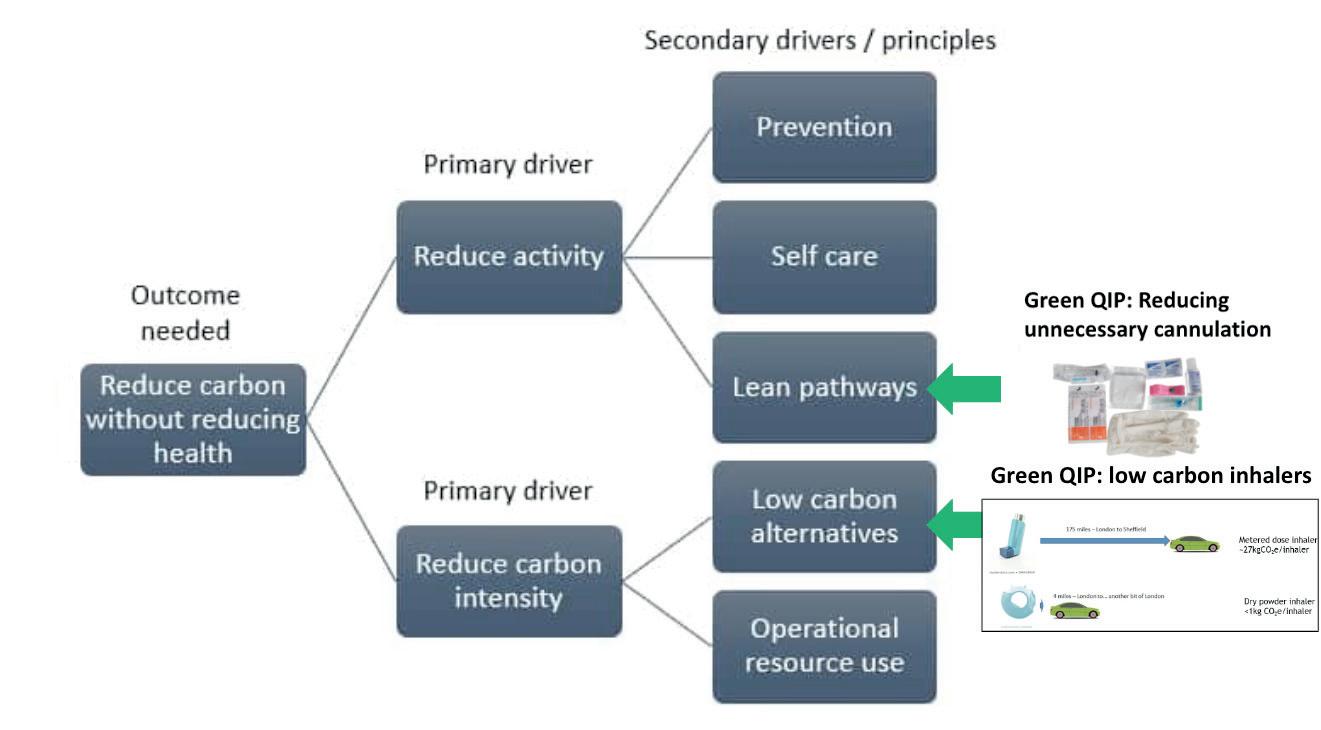
Optimised monitor settings, improved waste segregation and the elimination of single-use plastic in catering would all fall under ‘operational resource use’.
Each QIP can be plotted on a spectrum that shows patient-focused or ‘light green’ QIPs at one end and purely environmental or ‘dark green’ QIPs at the other (see the Infographic below).
Note. A series of ‘QIP starters’ that outline the rationale behind the above projects, with relevant case studies and ‘how to’ guidance, will be made available as part of a Green QI pack on the GreenED resources hub in the summer of 2023. Watch this space!
33 Environmentally Sustainable Emergency Medicine
These green QIPs can be mapped onto the SusQI driver diagram:
Infographic: ‘Spectrum of Green QIP’


Green QI tools
A ‘QIP Starter’ template, sample fishbone diagram and other diagram(s), sample usage reports and data collection proformas will be issued as part of the Green QI package in the summer of 2023.

VII. Communicating wins and challenges
The GreenED network
34 Environmentally Sustainable Emergency Medicine
The Emergency Care Sustainability Network, hosted by the CSH, is an online community for healthcare professionals who are passionate about reducing the environmental impacts of emergency care. The network is intended to be a place in which to share examples of how this problem can be tackled and to generate ideas regarding ways to improve the environmental sustainability and resilience of emergency care in the NHS.

The network has been running a monthly Zoom forum since March 2023. This is set to continue. You can sign up and flag it to GreenED team members so that they can sign up too!
Another way to soundboard ideas, communicate challenges and share progress and wins is more locally, via both personal and departmental social media, and through other comms channels within your ED, hospital or Trust, e.g. Twitter, intranet updates, email lists. If your Trust has a green network, they’ll be able to help with this just ask your sustainability lead.
You can send anything you think is worth highlighting more widely to the RCEM’s GreenED team for promotion via central channels.

Although it has been developed within and is run by the RCEM, GreenED originated as a grassrootsdriven initiative, led by worried emergency medics who wanted to do something about the climate and ecological crises. It is part of a wide network of groups that work on climate and health in the UK. It is worth plugging into via their online platforms:
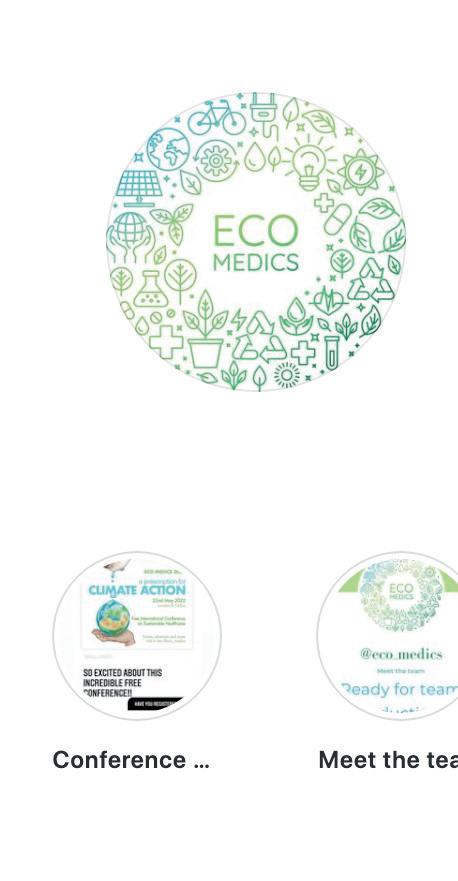

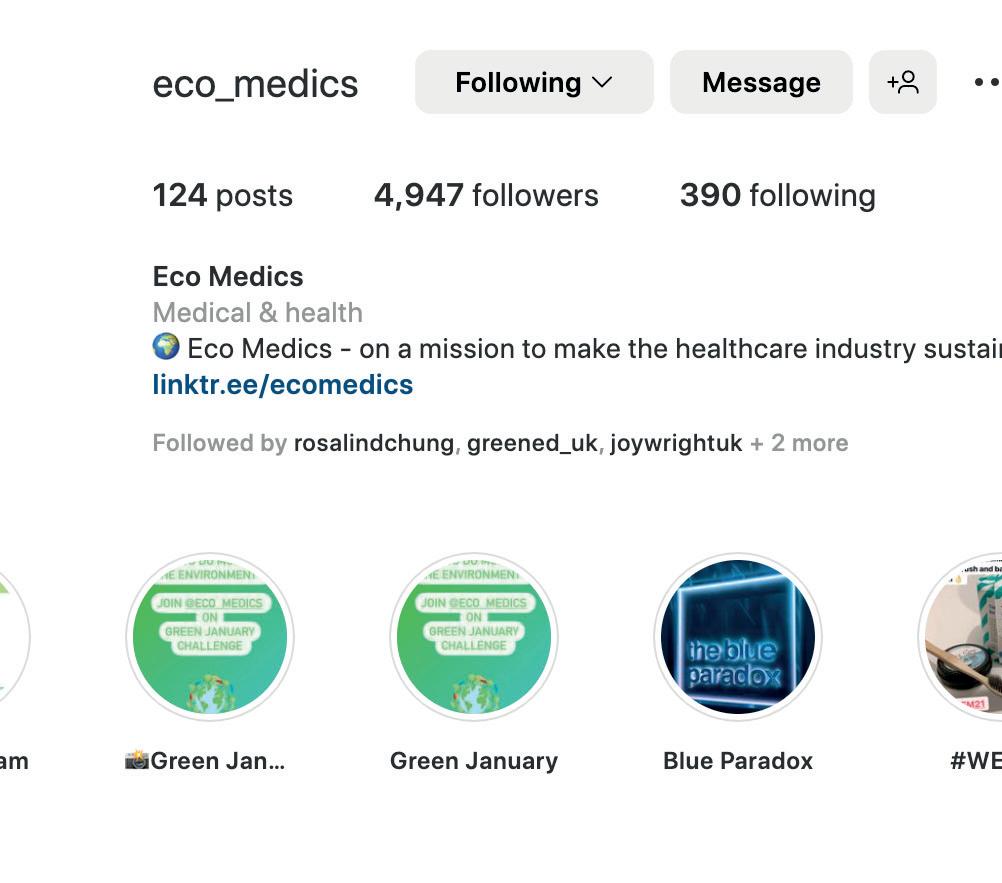


www.healthdeclares.org, www.ecomedics.co.uk and www.sustainablehealthcare.org.uk.

35 Environmentally Sustainable Emergency Medicine
Visual assets: Sample staff engagement posters and the GreenED style guide
Note. More sample posters that encourage staff engagement, and a generic slide bank to use as a basis for PowerPoint presentations, will be added to the toolkit in the summer of 2023.



Environmental Awareness-raising days

36 Environmentally Sustainable Emergency Medicine
blossomed Imp ov ng waste seg egation Appropr ate segregat on o was e (avo d ng unnecessa y andf l and nc nera ion) Queen V cto a NHS Founda on Trus Low energy l ght ng LED ght ng upgrade Pred cted ca bon sav ngs equiva ent to CO2e from 2786835 km by car Ma dstone and Tunbr dge Wel s NHS Trus Tu ning off computers and educing moni or br ghtness Au omat c PC shutdown sys em at n ght Es 800 onnes CO2e saved per year NHS O dham Pr mary Ca e Trus Reducing pape use Doub e-s ded pr nt ng and d g ta documen at on Sav ngs equ va en o CO2e rom 53592 km by ca and £10 000 pe year Wes Kent P ma y Care Trus Reduc ng unnecessary g ove use G oves O f campaign Reduced 21 tonnes of p as ic per year G ea O mond S reet Hospi a NHS Founda on Trus Reusab e sharps b ns 92% reduc ion in carbon em ss ons compared to s ngle use Un ve s y Hospi a s Covent y & Warw cksh re NHS Trus Reduc ng p astic cups Reduced s ngle-use p ast c in cater ng by 66% Sheff e d Teach ng Hosp ta s NHS Foundat on Trus Act ve t anspor Encouraging susta nab e rave amongst staf 25% reduct on n a r po ut on Cen ra Manches e Un ve s y Hospi a s NHS Founda ion T ust greenED pilot
Some ideas have already
Get in touch
The RCEM’s GreenED team comprises EM clinicians (all of whom are part of the ESIG) and RCEM staff members. You can email us individually or via greened@rcem.ac.uk with any ideas, information, questions or feedback.
To be part of the growing GreenED network, sign up to our mailing list (if you haven’t already) to receive a quarterly update email, and follow @GreenED_uk on Twitter and Instagram.
Elizabeth is the GreenED project manager. She is a neuroscientist, project consultant, Churchill fellow, and founder of MindTorch, a mentoring organisation for students. Over the last ten years, she has worked as an independent strategy, policy and equity consultant with academic, pharmaceutical and charitable organisations such as the UK Dementia Research Institute, Roche Pharmaceuticals and Alzheimer’s Research UK (Brain Banks, Expand Minds).
An EM doctor from North West England, Frances enrolled Royal Preston Hospital in the GreenED project in 2021 and achieved bronze-level accreditation as the pilot site lead. She formally joined the ESIG as the EM trainees association representative in 2022, and continues to work with the GreenED team to progress the GreenED programme. She is currently taking a year out of training to complete a clinical fellow position in sustainable EM. Outside work, Frances spends as much time outdoors as she can, walking in the Lake District or on her allotment with her children.


Gordon is the chief executive of the RCEM and a member of the ESIG. His professional background is drawn from private, public and charity sectors, including in the NHS. His brief includes leading the team of over 70 staff and working closely with the executive on policy and governance matters including improvements to college systems and addressing the challenges that face EM, including climate and environmental crises.

Anu is an EM consultant in North West London and an ESIG member. Married to a writer, they have a somewhat exuberant young daughter and somewhat chilled black Labrador. Anu is a QI-obsessive and a point-of-care ultrasonography enthusiast. So far he is on track to meet his career objective of having at least one slide of former Manchester United Football Club manager Alex Ferguson in every talk he gives. Anu is acutely aware of the global threat of the climate crisis, and the role that a colossal organisation such as the NHS can play in facing it. As a constantly active EM staff member, he believes that we have a particular responsibility to reduce emissions. His ED is focused on making a series of small changes that collectively will have a big impact.

37 Environmentally Sustainable Emergency Medicine
Elizabeth Adelodun
Gordon Miles
Frances Balmer
Anu Mitra
Nigel is the RCEM’s director of corporate services and has been a core member of the GreenED team since 2022. As of 2023, he is an ESIG member and interim lead of the RCEM’s Quality Cluster.


Tim is the vice-chair of the ESIG and post-certificate of completion of training fellow based in Brighton. He helped to draft actions for Framework 1.0 and carbon calculators for Framework 2.0. In 2022, he co-led the King’s College Hospital GreenED pilot site. He has an interest in reducing the use of anaesthetic gases and carbon footprinting in the ED setting. He has presented on sustainability topics at the RCEM Annual Scientific Conference and the RCEM ESIG training day. When not at work he loves to explore the South Downs, swim in the sea (fair weather only!) and commute by bicycle to distant hospitals!

Sandy is chair of the ESIG and co-clinical lead of the GreenED programme. He is an EM ST6 currently working in Kirkcaldy Hospital, NHS Fife, and has completed his paediatric EM sub-specialty training. He has presented GreenED work both nationally and internationally, raising awareness of the climate impact of emergency care. He has represented the RCEM in the national media, by highlighting the health effects of heatwaves and air pollution. When not working, Sandy spends his time with his wife and two daughters exploring the Scottish countryside.
Zoe is a co-founding member of the ESIG and co-clinical lead of the GreenED project. She has a background in campaigning, advocacy and film-making to raise awareness about the climate crisis from a health perspective. In 2021 she completed a clinical fellow post in QI for environmental sustainability as part of her role as a non-training EM middle grader at the Royal Free Hospital in London, where she was a pilot site lead before she went on maternity leave in early 2022. She now balances clinical work with GreenED and looking after her exuberant one-year-old son. She struggles to offset their combined carbon footprint due to being a dual citizen of the UK and Australia!

Hannah is an ESIG member and ST4 based in Brighton, who helped to create GreenED Framework 1.0. She was the GreenED pilot site lead at the Royal Sussex County Hospital and has developed a reusable suture pack prototype. She also initiated the first QI project in energy saving through optimisation of the settings of departmental screens. Both initiatives have gained hospital-wide recognition.

38 Environmentally Sustainable Emergency Medicine
Nigel Pinamang
Tim Spruell
Sandy Robertson
Zoe Steley
Hannah Webb
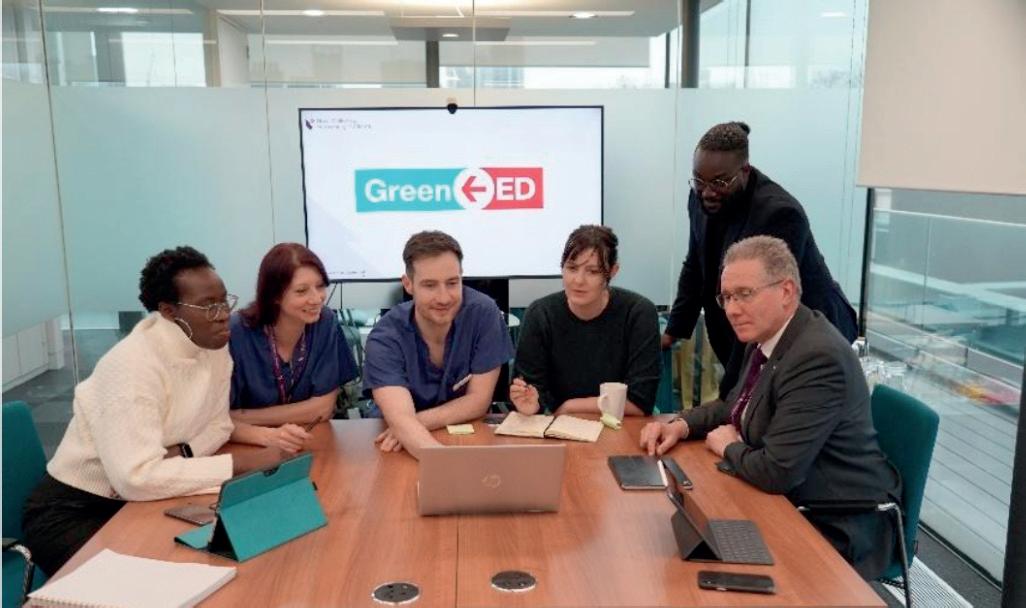
39 Environmentally Sustainable Emergency Medicine
Figure X, GreenED team members meeting on-site at the RCEM (Octavia House), February 2023
Glossary: Net-Zero NHS Terms
Carbon
Carbon is generally used as shorthand to refer to all human-made GHG emissions, the majority of which are carbon dioxide (CO2). Other GHGs include methane (CH4), nitrous oxide (N2O), sulphur hexafluoride (SF6), hydrofluorocarbons (HFCs), chlorofluorocarbons (CFCs) and perfluorocarbons (PFCs).
Carbon footprint
The amount of direct and indirect GHG emissions released into the atmosphere as the result of activities by a given individual, process, product, country or organisation. ‘Footprint’ is a metaphor for the impacts of these GHGs, typically expressed in CO2 equivalents (see below).
Carbon literacy
The awareness of the carbon costs and impacts of everyday activities and the motivation to reduce those emissions.
Carbon negative
The reduction of an entity’s carbon footprint to less than neutral, so that the entity has a net effect of removing CO2 from the atmosphere rather than adding to it.
Carbon removal
Human-caused withdrawal of GHGs from the atmosphere and storing them on Earth. These include the enhancement of natural sinks of CO2 such as trees and peatlands, or the use of engineered technologies to achieve long-term removal and storage.
CO2 equivalent (CO2e)
GHGs can be measured in comparable terms through the use of the construct CO2 equivalent (CO2e). CO2e specifies the amount of emitted CO2 that would cause the same impact on climate change for a given GHG or mixture of GHGs. For example, 1kg of emitted N2O would cause the same warming impact as around 265kg of emitted CO2, and can be expressed as 265kgCO2e.
Net-zero emissions
Net-zero represents the achievement of an overall balance between GHG emissions and GHGs removed from the atmosphere. Net-zero is the point in time at which we add no further net emissions and achieve climate neutrality
Zero emissions
When no carbon is emitted and therefore there is no release of GHGs into the atmosphere, then GHG emissions are zero. Achievement of absolute zero emissions is not possible for all aspects of healthcare, which is why carbon removals are required to reach netzero emissions.
40 Environmentally Sustainable Emergency Medicine
41 Environmentally Sustainable Emergency Medicine
Control Version number Date Author Update information V1 5 May 2023 GreenED team GreenED Handbook
References: shown in footnotes Version
42 Environmentally Sustainable Emergency Medicine








































































































